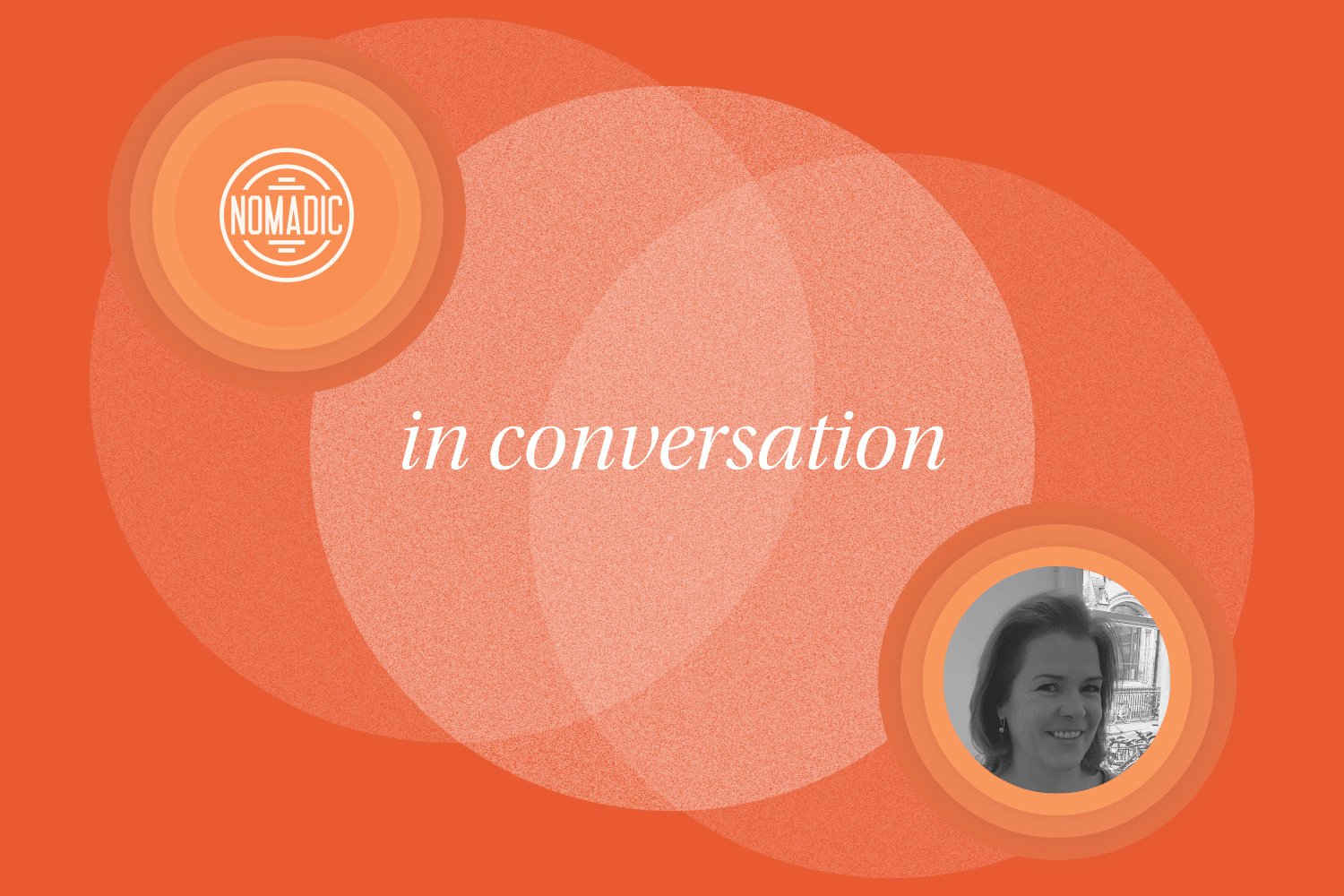Why digital academies are the best tool for marketing capability building
Jan 06, 2023 by Erin Becker

Note from Nomadic: This blog post was partially drafted using ChatGPT. We've long been interested in how technology can make work better, and have used artificial intelligence in different aspects of our workflows across the organization for more than a year now.
The recent launch of the ChatGPT tool gives us another way to do this. Like our learning experiences, we think anything we put in the world should be deeply human, even if––and perhaps especially if––it lives in the digital world, or was created using digital processes. We're going to keep experimenting when it comes to AI and machine learning's role in our work. In the end, it's learners and their organizations who will benefit from an optimistic-yet-thoughtful approach to the role AI takes in any L&D solution.
In the meantime, we're having a lot of fun exploring the possibilities. If you'd like to chat about AI in marketing, learning content, and beyond, feel free to email me at erin@nomadiclearning.com.
–Erin Becker, director of marketing, Nomadic
Why is marketing capability building so important today?
Marketing capability is more important than ever before. Between marketing’s constantly changing landscape, the proliferation of digital channels, and the rapidly increasing amount of data available to marketers, it is essential for businesses to stay up-to-date on the latest marketing techniques and technologies in order to remain competitive.
By seeking out ways to continuously build their marketing capabilities, businesses can better understand their customers and target markets, and develop effective marketing strategies that will help them reach and engage their audience, whether that’s developing better processes, deepening creativity, or thinking in new ways about the brand story.
Marketing capability building must be fast––and effective
Old, slow-moving ways of building capabilities just won’t work in this new environment. You can hire the top people and ensure they have access to cutting-edge technology, but if your teams aren’t constantly learning new skills and ways of working that help them rise to the occasion, your results (and ultimately, your revenue) will eventually fall behind.
The COVID-19 pandemic and resulting changes to how businesses everywhere operate has further emphasized the importance of marketing capability building. As the world has moved increasingly online, brands have had to adapt their marketing strategies in order to reach their customers and continue to generate revenue. Marketing capability building can help businesses navigate these challenges and emerge stronger and more resilient in the face of future disruptions, not only keeping up with the pace of change, but ultimately driving business transformation that will help them stay ahead of it.
Learning for marketers: exceeding expectations
But––as we hear time and again from our clients focused on marketing capability building, whether they’re marketers by trade themselves or come from an L&D background––marketers are a demanding audience when it comes to the quality and relevance of their learning solutions. Used to the high standards of agencies and competitive in-house teams, marketers are accustomed to paying a rigorous amount of attention to the details of visual design, narrative storytelling, and user experience within their own work. They also understand the attention economy, and know that any piece of content or media must be relevant and engaging in order to earn the audience’s time.
Any learning solution for marketing capability building needs to meet, and exceed, these expectations in order to keep marketers engaged and make it impactful for both the learners and the business at large.
Fast, effective, and well-designed: it’s a tall order for any learning solution. Fortunately, we have seen that digital academies are up to this tall task.
In our work with clients, we’ve observed how this style of collaborative learning is uniquely suited to the goal of delivering high-quality, high-ROI learning to marketing teams, especially for global enterprises.
Why is social and collaborative learning so effective for marketers?
Digital academies are different from other forms of online learning because they are social and collaborative. It’s not just about learning––it’s about exploring topics together, in learning cohorts, in an online environment that deepens and strengthens that learning through interactions with your peers.
Social and collaborative learning is characterized by the exchange of diverse ideas and perspectives. This type of cohort-based learning is effective for many functions, but particularly for marketers, who work in a highly collaborative environment that demands a deep understanding of the way people think.
In a marketing academy, learners work together, sharing different experiences and knowledge. The collaborative learning experience allows learners to discuss and reflect on marketing material with their peers, offering a more thorough and nuanced understanding of marketing concepts. This can lead to a stronger foundation of knowledge and the ability to apply marketing techniques in a variety of contexts and across a variety of audiences.
In this way, social and collaborative learning results in a more well-rounded understanding of marketing concepts and strategies, as well as an appreciation of new perspectives that can strengthen a marketer’s craft and lead to more creative marketing campaigns.
Building marketing skills through collaborative learning
Social and collaborative learning also helps hone skills that marketers can apply outside their own teams. Marketing that often requires the ability to effectively communicate ideas and present them to clients or stakeholders. It also necessitates the ability to work with a team to develop and execute marketing campaigns. These skills are essential for success in the field and can be enhanced through social learning, which helps to strengthen these capabilities that marketers can then use in many different aspects of their work.
Likewise, collaborative learning can also provide opportunities for real-world practice, which ultimately spurs the mindset shift and behavioral change that makes learning truly effective. When learners are able to explore cutting-edge marketing topics alongside their peers, they can gain hands-on experience in applying these new concepts and strategies. This can be more effective for learning than simply reading about marketing techniques in a textbook or watching videos while advancing through a series of modules alone.
Finally, collaborative learning can create a sense of community and support. When learners work together, they gain a feeling of belonging and support for one another. This can foster a more positive learning environment and help learners feel more comfortable asking for help when needed, creating the psychological safety necessary for marketers to hone their skills in some of the more challenging aspects of their work. These might include discussing disagreements about campaigns, overcoming unexpected obstacles, pivoting quickly when objectives change, and thriving amidst the friction that is part of any creative process (and often leads to the best results!).
How do marketing academies drive learner engagement?
In addition to simply being more effective at helping marketers build the skills they need to build to succeed in this fast-paced field today, marketing academies are also excellent for increasing learner motivation and engagement. When learners are able to work with their peers and share in the learning process, it can make the material more interesting and relevant. This can lead to a greater investment in the learning process and a desire to actively participate.
Often, our clients report record levels of engagement once learners begin moving through our cohort-based academies. For example, in our AB InBev marketing capability academy, 89% of learners completed the initial Program, a multiple of previous completion rates, which were for programs with much lower bars for completion. Similarly, PepsiCo's marketing academy saw record levels of engagement, even with non-mandatory multimedia learning resources, which employees accessed more than 8,600 times.
At these companies and other similar global marketing teams we work with, these busy, high-performing employees had historically struggled to find time for learning. But features of the cohort-based learning experience––the encouragement from their peers, the friendly competition between teams, and the ability to apply the learned material to their real-world jobs right away in discussions and debates with fellow cohort members––all made the digital marketing academy a highly motivating experience for these learners.
Gamification aspects like badges, a leaderboard, nudges, and progress bars that show learners how much they have left to complete help foster that engagement, too. These learning design elements, paired with great design and user experience, help capture the attention of the highly social, competitive, and savvy audience of learners that marketers tend to fall into.
Why does digital learning work so well for marketers?
So we’ve talked about why social and collaborative learning is so effective for marketers, but what about the digital aspect? Many people believe that live, in-person learning is preferable to online alternatives. This is often based on their own bad experiences with “click-next e-learning,” MOOCs with miniscule completion rates, or online learning that tries too hard to replicate the in-person classroom, rather than thinking creatively about how to take advantage of experiences that could only live online.
Digital academies are different, but they need to follow best practices to be effective. In-person learning can be rich, impactful, and rewarding, and online learning will never fully replicate that experience––and shouldn’t try to! Digital learning does other, completely different things well, particularly for large, global, and distributed teams.
With digital learning, you can:
- Scale your learning across a global marketing team. Digital learning can be more cost-effective than in-person training. Training large groups of employees can be expensive, especially when it requires travel and accommodations. Digital learning eliminates these costs and allows businesses to train a larger number of employees for a lower price. It’s also faster: there’s no need to wait for learning to “trickle down” from the select few who were invited to attend the in-person experience, so it’s a better option for a global team looking to keep up with the pace of change today.
- Create an accessible learning experience for everyone. Digital learning enables you to translate the learning content into multiple languages and make it accessible to all learners through closed captioning, transcripts, audio features, and more.
- Allow learners to engage with the learning at their own pace, in the flow of work. Digital learning allows for flexibility and convenience. Employees can access training materials and resources at their own pace and from any location with an internet connection. This can be particularly beneficial for businesses with employees in different locations or with varying schedules. Note that even with asynchronous learning, you can set time constraints that help drive engagement, such as requiring learners to complete a set of modules within a timeframe of 4–5 weeks. (This is what we encourage in our semi-synchronous learning format.)
- Provide a dynamic learning experience that uses different formats, like video, interactive quizzes, infographics, micro-stories, and more. Without an inspired instructor, in-person learning isn’t always particularly interactive––how many of us remember sitting through long lectures in university classes, struggling to stay engaged? With digital learning, you can build the interactivity into the academy’s design, which can lead to a more effective learning experience and a higher retention of material.
- Keep your learning up-to-date easily. Digital learning allows for easy updates and modifications. With traditional in-person training, it can be difficult and time-consuming to make updates to training materials. With digital learning, updates can be made quickly and easily, ensuring that employees have access to the most current information and best practices.
- Track deeper and more useful analytics. Digital learning provides the ability to track and measure employee progress. Many digital learning platforms include tools for tracking employee progress, such as quizzes and assessments. This can help businesses determine which employees may need additional support and identify areas where training may need to be improved. With collaborative learning that includes in-depth discussions between employees about topics highly relevant to their work, qualitative analytics become especially relevant as a source of solutions to sticky problems and new product and process improvements. (To the extent that one CHRO called our digital academies an “insights machine.”)
In this way, the best digital learning isn’t trying to mimic in-person learning. Rather, it’s providing an effective solution to a whole different set of problems emerging in the capability building landscape today.
We’ve worked with many global marketing teams who find that digital marketing academies are the best way to solve the set of problems presented by the task of building marketing capabilities now, and have been thrilled to see their success: read about AB InBev’s recent Cannes Lions win!
Digital marketing capability academies: where to learn more
Building marketing capabilities is no easy task, but there are a few resources to help you get started:
- Our report on eight principles for creating a cohort-based learning experience at scale is a good introduction to how large enterprises execute collaborative learning effectively across various functions.
- We also like this First 100 Days of a Marketing Capability Leader playbook from the World Federation of Advisors, and recognized several familiar faces of leaders we’ve worked with offering their advice and wisdom.
- If you’d like to test out the academy experience yourself to explore more about cohort-based learning firsthand, simply sign up for our newsletter below and you’ll be the first to hear about free quarterly experiences where you can pilot one of our Programs alongside colleagues from around the world.
*
Sign up to get the latest expert commentary, analysis, and news in learning and leadership delivered straight to your inbox, and to be the first to hear about our free cohort-based academy experiences.
.png)


